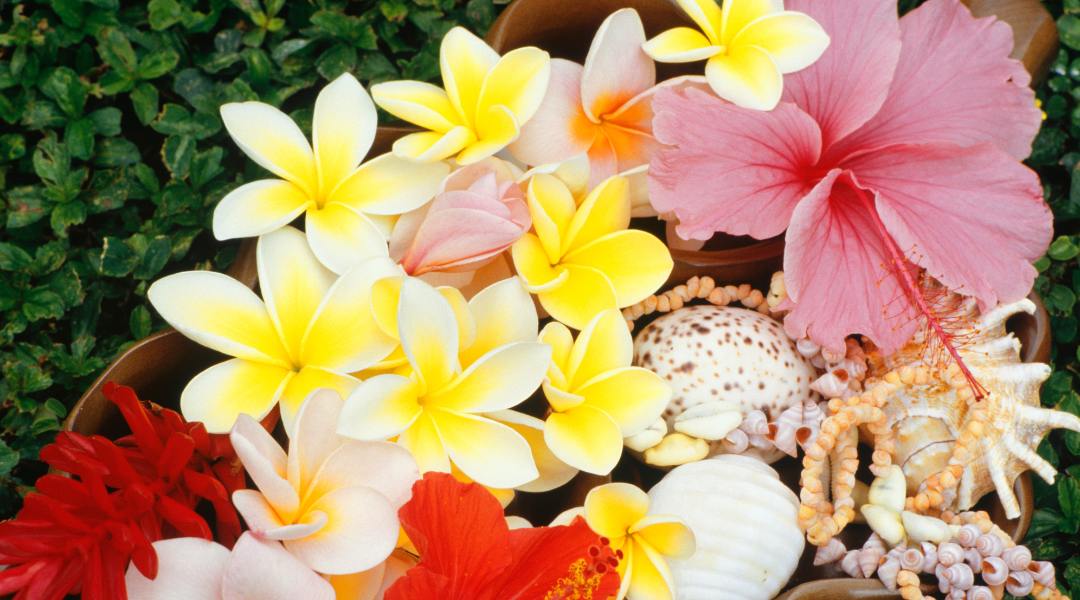Bird of Paradise
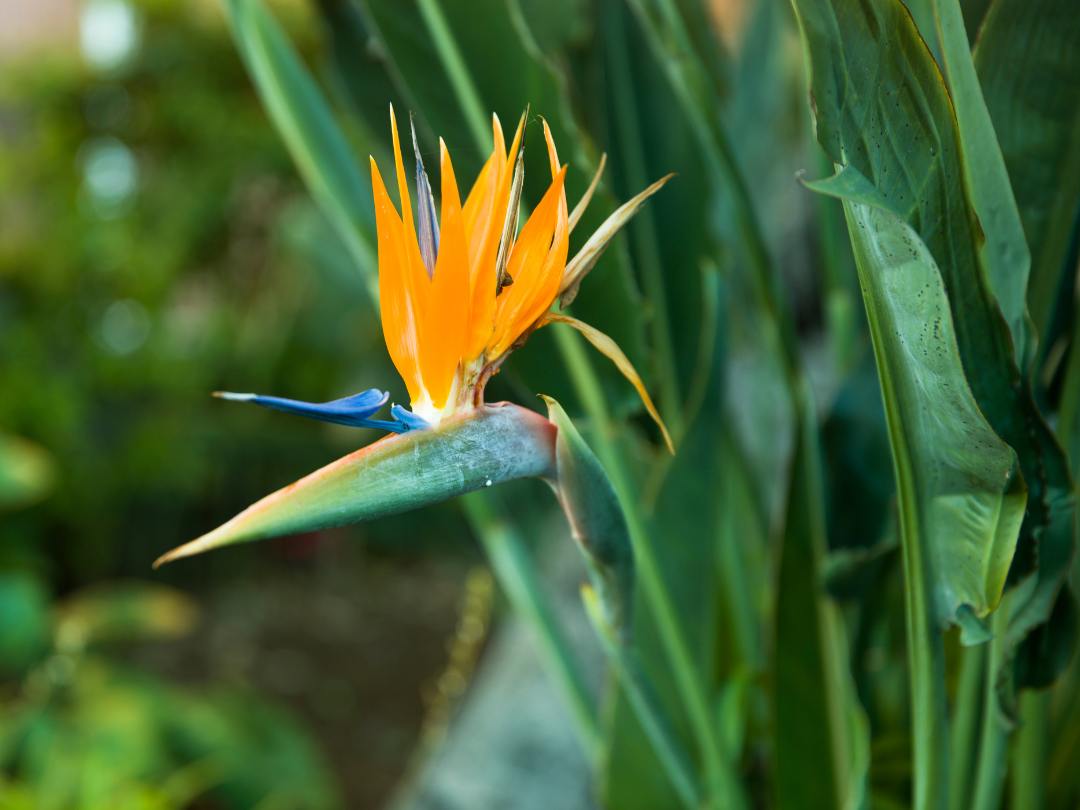
Well, the name of this plant pretty much sums it up. This sun-loving plant has beautiful orange and blue flowers that strike the pose of a colorful bird in flight. Sometimes that takes more imagination to see. These flowers aren’t scented and you won’t see these large flowers in a lei, but they do make excellent cut flowers.
Did you know there’s a BIG bird of paradise?
The botanical name for bird of paradise is Strelitzia reginae. There’s also Strelitzia nicolai which may look the same as Strelitzia Reginae when both plants are young and in a 5-gallon pot. But, nicolai, well, is more of a tree. This Strelitzia gets to about 25’ and has pale white flowers. Strelitzia nicolai is also known as wild banana or giant white bird of paradise. This is the bird of paradise you’ll most often see indoors because it’s better at taking low light situations. With its big, rich green leaves and upright growth, this giant white bird of paradise is an excellent tropical accent to your home or office. The smaller Strelitzia reginae likes lots of light (and even with lots of light, it will seldom bloom indoors).
Oh, and don’t get Strelitzia reginae confused with Strelitzia juncea. This latter tropical plant has the lovely flower, but very narrow leaves, and is aptly referred to as narrow-leafed bird of paradise. Because the leaves of these tropical plants are one of the many reasons I love Strelitzia reginae, I seldom plant Strelitzia juncea.
Bird of paradise, Strelitzia Reginae, gets to about 6’ tall and 4’ wide. I plant a lot of these tropical shrubs. They are very dependable outdoor plants in USDA zones 10 and 11. They take sun and some shade, can be grown indoors or out, in a pot or in the ground, and are low maintenance and drought tolerant.
In the garden you can mix bird of paradise in a planting bed with Mediterranean plants like rosemary, lavender, lantana, bougainvillea, and euphorbia. With some of these plants, you can choose an orange variety, like Bougainvillea x buttiana ‘Orange King’ or Lantana camara ‘Bandana Orange—that will bring out the orange of the bird of paradise.
In your home, bird of paradise can bring a tropical accent to a sunny and warm spot. The plant thrives in warm temperatures, around 65-80 degrees F. If you do too, your plant will be more than fine at room temperature. If you don’t have a spot with enough direct light—or even bright indirect light—you can use a grow light. But again, don’t expect many blooms from these tropical plants indoors.
Grow lights are not the ugly utilitarian fixtures they used to be! Fear not, light-impaired. Growing tropical plants indoors may take some help, but there are hanging pendants, decorative bulbs and under-cabinet lights that can solve your darkest problems.
Orchids

We were at a restaurant in Maui and were served an orchid with our mocktails. Orchids, as it turns out, can be edible! While you do want to avoid eating any edible flower unless specifically cultivated for consumption, since it was sitting in our drinks, we went for it.
The most common orchids for culinary purposes are dendrobiums (den-droh-bee-um) and epidendrums (eh-pee-den-drum). These are not the most common types of orchid.
Phalaenopsis, also known as ‘moth orchids”, are the most common type of orchid. These tried and true houseplants are easy to grow, and they stay in bloom most of the year. They have elegant, arching stems with sprays of flowers and large, firm, green leaves at the base. I think we’ve all been at the receiving end of one of these plants. Paphiopedilum, known commonly as slipper orchid, is another popular orchid and houseplant.
My favorite orchid is the one that was in our drink—the beautiful dendrobium orchid. It’s less likely to be found at Trader Joe’s, but is still easy to find. In n the right climate, these tropical plants are also easy to grow.
Edible Orchid
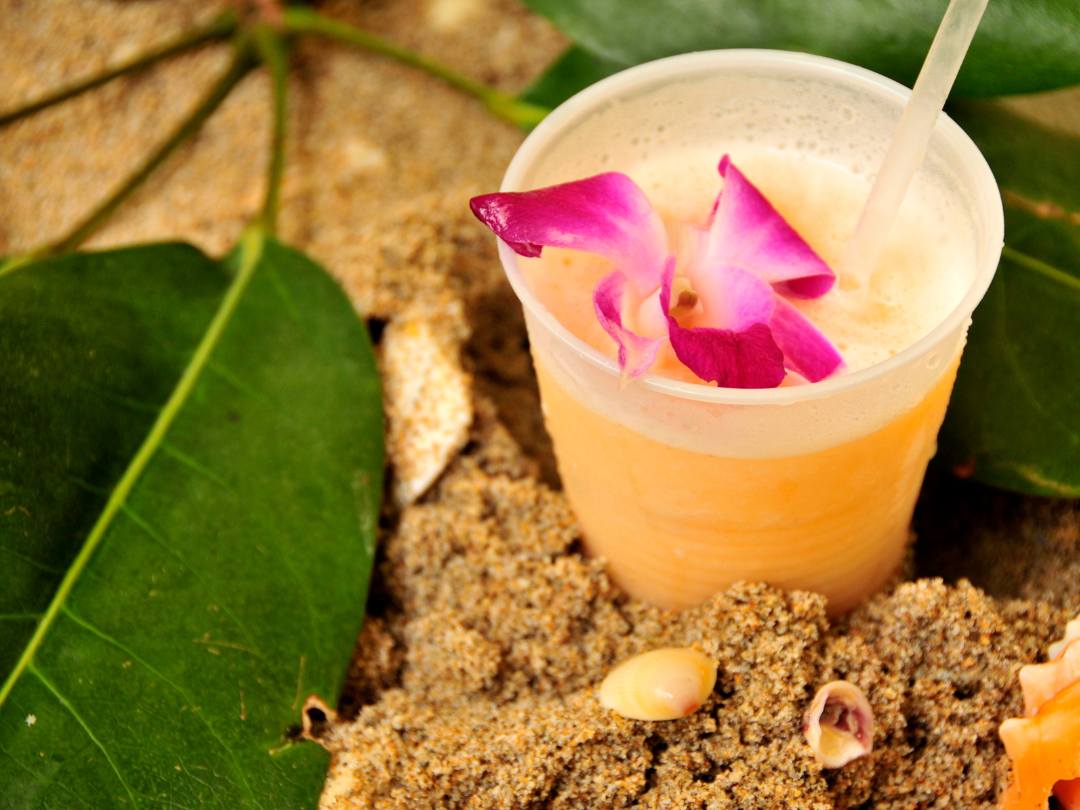
You’ll see the dendrobium orchid being used in drinks and recipes. Yes, recipes! You can throw them into your salad, fry them up as orchid tempura, crystallize them to add to a dessert, or even freeze these blooms in an ice cube. They taste like a mild watercress or endive.
The most common way people cook with orchids is by using the pod of the vanilla orchid, Vanilla planifolia. Yep, this vining plant that produces the vanilla bean is an orchid! But this post is about flowers, so let’s move on.
Orchid Leis

Orchids are one of the most popular flowers for making leis, and dendrobium orchids are the type that are used most often. These beautiful flowers come in many colors and are durable. A cut orchid will last up to ten days in the refrigerator, and will take the abuse of stringing and wearing. Beauty and sturdiness are both a big plus in lei making.
In case you don’t know what a lei is, it’s a necklace made from flowers or other items worn around the neck. How-to videos can help you understand how to make one. A good place to start is with a video by Renee Tucci. I like her use of hypericum berries and Israeli Ruscus, both of which I can find at my local grocery store.
Leis usually use a thread that’s about 36-40” long and around 60 flowers. You can also make a double orchid lei. It takes about 150 flowers to make this lei, but it’s extraordinarily beautiful. My favorite leis mix the vibrant colors and sturdy flowers of the dendrobium orchid with the heavenly scent of the tuberose.
No orchids? No problem! You can also make a lei with plumerias, roses, tuberose, pikake (jasmine), carnations, ginger, hibiscus, and more.
Torch Ginger
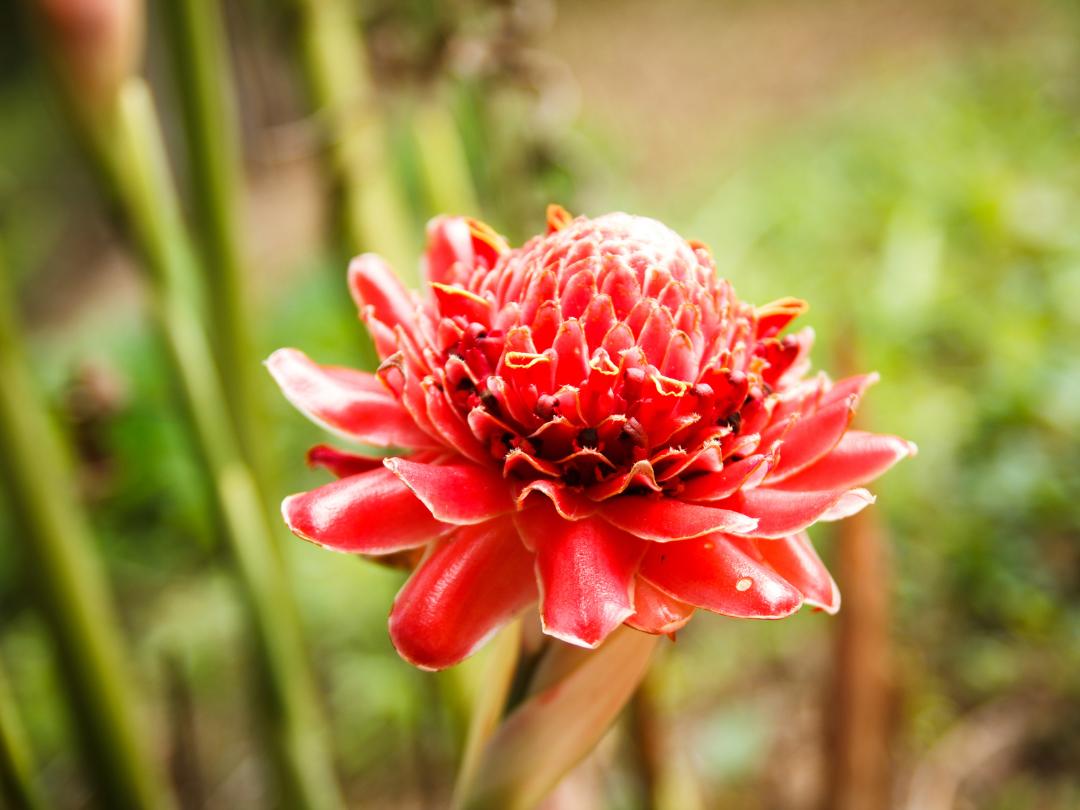
This one is easy to remember because it does resemble a torch on fire. The plant itself can get quite big—about 15’ tall and almost as wide. The flower of the torch ginger is usually red, but it can also be pink or white.
Torch ginger is a widely used cut flower. Given the common name ginger, my daughter asked if it was edible. It wasn’t the source of the ginger I knew, so I thought no, I don’t think this plant is edible, it doesn’t look edible. But, like much in the botanical world, it was much more confusing than I thought.
The true culinary edible ginger that’s familiar to us is from the root of the plant Zingiber officinale. I believed this ginger, Etlinger, which is also commonly known as “Torch Ginger” or “Stone Rose” was just a tough, long lasting ornamental ginger. This lovely ginger is often used in floral arrangements and, to my surprise, it is also used in cooking.
In floral arrangements, the flower of the torch ginger can last a LONG time. While you don’t want to be spotted going in to take a whiff of a bird of paradise blossom, you will want to lean in to smell the sweetness of this bright blossom.
While this isn’t the culinary ginger I’m familiar with, all parts of this plant are edible! In Thailand, Malaysia, Singapore, and Indonesia cooks use the flower bud sliced or shredded to spice up dips, salads, and sauces. The unopened flower is eaten raw and cooked. The root of the plant is also eaten.
Again, I wouldn’t go making a dish with any flower unless I knew it was grown for culinary purposes.
Hibiscus
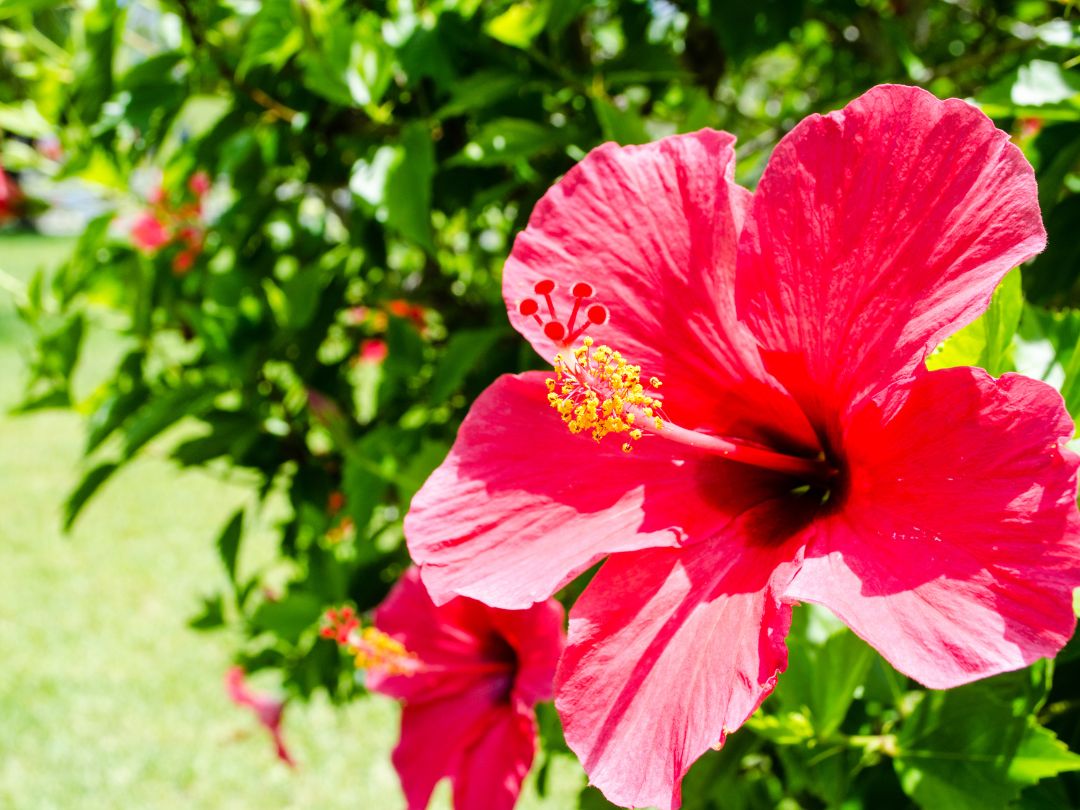
There are so many different types of hibiscus, and we’ve covered some of the species and varieties of this beautiful tropical plant before. For this study I think we can narrow this flowering plant to the most common tropical hibiscus found in nurseries, Hibiscus rosa-sinensis. This hibiscus is commonly known as Tropical hibiscus, Chinese hibiscus, Shoeblackplant, and Hawaiian hibiscus.
Even narrowed, there are many different types of tropical hibiscus, with a large variety of flowers ranging in both size and color. Most commonly, the flower is red, pink, yellow, orange, or white. The cultivated varieties have single or double flowers in a large variety of colors.
I can’t help but notice there is no black flower involved and wonder how the tropical hibiscus plant got a common name like Shoeblackplant. As it turns out, the juice from the darkened, wilted flowers is used to make blue-black dye for shoe-blacking, eye-liner, and mascara.
Hibiscus is not a long lasting flower. But its beauty and temporary quality allows you to show it off and tuck it behind your ear! Just remember which ear means your single (right) and which ear means your taken (left). The flower is also used ornamentally as a food garnish because it can last the day, but just the day, out of water. These flowers are also edible!
Like we mentioned above, you can make a short-living lei using hibiscus. Hawaiian hibiscus are a larger flower than most lei flowers, so instead of around 60 flowers you’ll just need to collect 35-40 flowers. You’ll need to remove the stamen before stringing the flowers together.
Plumeria

There are thousands of varieties of plumeria. Personally, I’m more than satisfied with the common yellow cultivar called Plumeria acuminata. The flower is creamy white on the edges with a sunny yellow in the center. This plumeria flower has a strong lemon fragrance and excellent keeping qualities.
The common name for this plumeria is Common Yellow or Graveyard Yellow. It’s one of the most common plumerias in Hawaii and is said to be the first cultivar introduced to the island. Yes, that’s right, plumeria is not native to Hawaii. Plumeria trees are endemic to Mexico, Central America and the Caribbean. This plumeria’s long lasting fragrance and low maintenance earned it a spot in graveyards.
This beautiful flower is one of the most popular flowers for making leis. And this flower has a heavenly lemon scent! My suggestion would be that before you go to Hawaii or another tropical location that you know will have these divine blossoms, get your lei-making accouterments ready!
Tropical does not have to mean lots of water. Plumerias can survive with little moisture because they can hold an excess amount of moisture in their stems and branches. If you’ve seen a plumeria tree, this won’t come as much of a surprise. When my kids were younger, they would call them dog bone trees. At the airports in Hawaii, you’ll see cuttings of plumeria packaged to bring home. These cuttings do look like a bone you would give a dog.
Cuttings are not the only way this tree is propagated. An even better way to propagate plumeria is by its seeds, which grow in pods. The plumeria seed pod is long, flat and green when immature, and it wilts and dries as the seeds ripen.
Plumeria, also known as ‘Frangipani’, can also be found in California, Texas, Florida and Arizona (basically, Zones 9-11). For more information about growing plumeria in southern California the Southern California Plumeria Society is a great website to check out.
Plumeria trees like sunny spots and need about 6 hours of direct sunlight to produce flowers. The flowers can be white, cream, yellow, pink, lilac, red, or a combination of these colors. In colder climates, you’ll need to keep the tree inside and give it 6-8 hours of full sun to bloom. You can learn all about the plumeria and plumeria varieties and cultivars on the website Plumeria Today.
We partner with select companies whose products and/or services we love. Some of the links on this page may be affiliate links. If you purchase an item using our affiliate link, we may receive a small commission (at no added cost to you). We appreciate your support.

